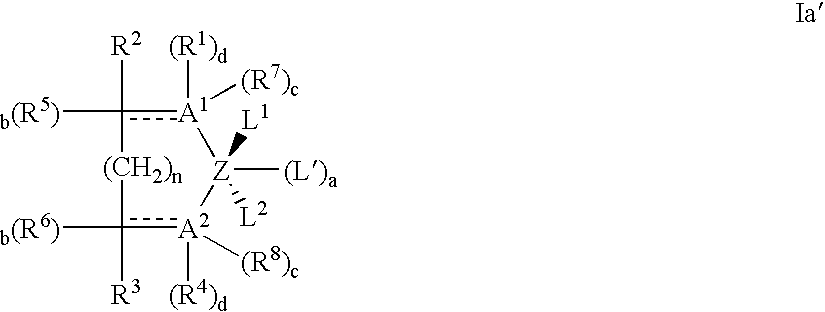Coordination catalyst systems employing chromium support-agglomerate and method of their preparation
a technology of chromium support and catalyst, which is applied in the direction of catalyst activation/preparation, physical/chemical process catalyst, chemical/physical process, etc., can solve the problems of oxophilic catalysts, difficult to handle borane and borate co-catalysts, and difficult to produce resins (with long chain branching) that are not possible, so as to achieve good catalytic activity
- Summary
- Abstract
- Description
- Claims
- Application Information
AI Technical Summary
Benefits of technology
Problems solved by technology
Method used
Image
Examples
example 1
Preparation of Support-Agglomerate
Part A—Preparation of Base Silica Hydrogel
[0267]Silica gel was prepared by mixing an aqueous solution of sodium silicate and sulfuric acid under suitable agitation and temperature to form a silica sol that sets to a gel in about 8 minutes. The resulting gel was base washed with dilute (about 2 wt. %) ammonia (NH3) solution at 65.5° C. (150° F.) for 18 to 36 hours. During this time, the silica gel was cleansed of salt by-products and the surface area was modified. The base wash was followed by a fresh water wash wherein the gel was placed in a re-circulating bath at 82° C.
[0268]The base washed gel was aged at 65-82° C. for about 36 hours and a pH of 6 to 7 for one sample designated 1A, and at a pH of 7.5 to 9 for another sample designated 1B. The surface area of the gel was thereby reduced to about 600 m2 / g for Sample 1A and to 300 m2 / g for Sample 1B. The resulting water washed gel of Samples 1A and 1B have a SiO2 content of about 35 wt. % with the b...
example 2
A. General Procedure for Preparation of Cr Immobilized Support-Agglomerate Material
[0286]The chromium immobilized support-agglomerate was prepared by spray-drying an aqueous mixture (contain about 15% solids) of clay [montmorillonite, APS (average particle size) about 1.5 μm], wet-milled silica powder (APS about 5 μm), sand-milled silica hydrogel (contain ˜25% colloid; APS about 5-8 μm), and chromium acetate solution (1 wt %). The percentages of the clay, silica powder and hydrogel may be varied to meet the desired specific physical properties of the particles. The SA (surface area) is normally between 185-600 m2 / g, while the PV (pore volume-N2) is from 0.6-1.6 cc / g.
B. Spray-Dry Feed Chromium Immobilized Support-Agglomerate (SDF)
[0287]A solid slurry of Example I, Table 4, Run 16 was mixed with 1 wt % chromium acetate solution. This slurry was used as spray dryer feed to give spherical particles having 464 m2 / g surface area and 1.24 cc / g pore volume (N2). The particle size for this m...
example 3
Activation Procedures of Chromium Immobilized Support-Agglomerate
[0288]About 30 c.c. of each catalyst sample were fluidized in a quartz tube (4.8 cm O.D.) which had a sintered frit to support the catalyst powder. Dry air passed through beds containing activated alumina (typically less than 1 ppm H2O) was used as fluidizing medium. The dry air flow rate was 40 liter per hour. The fluidized bed was heated at the rate of 400° C. / hour to the pre-set temperature, which was then kept constant for 5 hours. The quartz tube with the activated catalyst sample was then transferred to a glass container under dry nitrogen for storage. The Cr immobilized support-agglomerate (Example 2 Part B) to be used for supporting the bi- or tri-dentate ligand containing transition metal complexes were activated in fluidized bed with a stream of dry oxygen at temperatures of 800, 1,000, and 1,100° F.
PUM
| Property | Measurement | Unit |
|---|---|---|
| Length | aaaaa | aaaaa |
| Length | aaaaa | aaaaa |
| Length | aaaaa | aaaaa |
Abstract
Description
Claims
Application Information
 Login to View More
Login to View More - R&D
- Intellectual Property
- Life Sciences
- Materials
- Tech Scout
- Unparalleled Data Quality
- Higher Quality Content
- 60% Fewer Hallucinations
Browse by: Latest US Patents, China's latest patents, Technical Efficacy Thesaurus, Application Domain, Technology Topic, Popular Technical Reports.
© 2025 PatSnap. All rights reserved.Legal|Privacy policy|Modern Slavery Act Transparency Statement|Sitemap|About US| Contact US: help@patsnap.com



